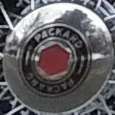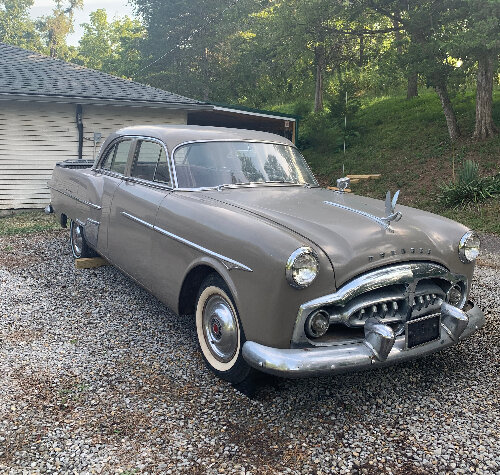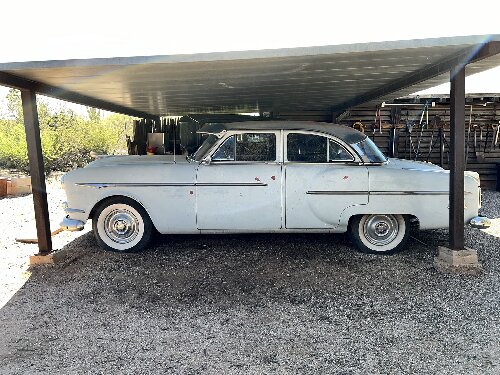|
Re: Dive & Screech
|
||||
|---|---|---|---|---|
|
Home away from home

|
Here it is, Ross
Quote: BRAKE ADJUSTMENT AND LINING PREP
Posted on: 2014/7/1 19:09
|
|||
|
Guy
[b]Not an Expert[/ |
||||
|
||||
|
Re: Dive & Screech
|
||||
|---|---|---|---|---|
|
Home away from home

|
Ahem,
Now if I might add a couple more things to stir the pot I was talking to a friend of mine the other day who said, to my horror, "That (dive and screech condition) can be caused by the master cylinder." Well, I told him 1, I didn't see how (he didn't explain" and 2. it was just rebuilt, but you know how lame that sounds. I doubt if it's the MC itself, but wonder if all the lines from the MC were completely cleared. It WAS doing the same thing when I first drove it on that wild 200 mile trip home after buying it (during which the brakes sort of worked, but were found to be in horrible condition later, including the linings and the MC which contained mostly "jelly"). I still don't know how they worked at all, and neither did my mechanic. BUT the screeching and diving continued even after all the work was done. I am hopeful that a thorough check of adjustment, springs, lines, hoses, drums and A arm bushings will spot the culprit. But, could it be the backing plate? Is there supposed to be brake grease applied, and where it should be? I didn't see this mentioned any place elsewhere. I'm really kind of anxious to get these things sorted out so I can get the car more roadable, and do more work on it MYSELF (anything that doesn't make it stop or steer, I'll tackle). I hate waiting for shops to squeeze in a job that they seem to think is charity-- even though I'm out about 2 g's so far. Maybe customers' money is worth more if they have new cars or drive them every day. I'm sick of getting "back-burnered" over someone else's dire emergency-- like getting to the "cabin" by Thursday. First it's the Memorial Day rush (there goes May) Then it's the 4th of July rush (there goes June) Then, maybe, you can find 2 weeks before the Labor Day rush.
Posted on: 2014/7/7 21:10
|
|||
|
Guy
[b]Not an Expert[/ |
||||
|
||||
|
Re: Dive & Screech
|
||||
|---|---|---|---|---|
|
Home away from home

|
RE: Backing plates and grease. I wouldn't think backing plates could cause the condition unless they were so rusted through that they've lost their structural integrity. I would expect your mechanic to note that and not do any work on the system until the plate or plates were replaced.
A small amount of grease is usually placed at the top and bottom edges (or toe and heel) of the metal shoe where it slides along the backing plate. These areas are an inch or less in length so a very small dab of grease is sufficient. Usually, you can see a mark on the plate in those areas. If those areas are deeply worn, the mechanic should recommend plate replacement. With the comment that the master cylinder was full of "jelly" I'm suspecting the lines and hoses to be likewise. The lines may have enough moisture in them to be rusting through from the inside out. They need to be carefully checked.
Posted on: 2014/7/8 11:10
|
|||
|
Don Shields
1933 Eight Model 1002 Seven Passenger Sedan 1954 Convertible |
||||
|
||||
|
Re: Dive & Screech
|
||||
|---|---|---|---|---|
|
Home away from home

|
Thanks, Don,
I am going to have the lines blown out again and check for equal fluid flow. The fluid was all changed and the system bled after the brakes and MC were rebuilt, but who knows what little bits of junk could still be lurking in there? Your info on the backing plate grease will be passed along, too. It goes into the shop next week, and I keep thinking: "This time fer sure!" (like those of us old enough remember, that's what Bullwinkle said before he tried to pull a rabbit out of a hat, which, of course, didn't work). But for me and my car, I know: THIS TIME FER SURE!
Posted on: 2014/7/9 22:26
|
|||
|
Guy
[b]Not an Expert[/ |
||||
|
||||
|
Re: Dive & Screech
|
||||
|---|---|---|---|---|
|
Forum Ambassador
|
Probably already been done but if going to the shop have the mechanic check the steel lines carefully to make sure there isn't a kink or crushed spot in the piece going across under the engine that would reduce braking on the front right wheel. If it has the fabric loom around the tubing there could be a crush and not be seen.
Posted on: 2014/7/9 22:37
|
|||
|
Howard
|
||||
|
||||
|
Re: Dive & Screech
|
||||
|---|---|---|---|---|
|
Home away from home

|
You're very welcome, Guy. Should they ask what kind of grease to use, I use anti-seize lubricant such as Permatex makes. It comes in an 8 oz. jar with its own applicator brush. I worked with a mechanic who did this and I commented that all the others use regular chassis grease. He replied that anti-seize works better so I copied him. Although I don't do a lot of brake work, I haven't had a problem in using anti-seize in this manner. Best of luck in getting your brakes fixed.
Posted on: 2014/7/9 23:02
|
|||
|
Don Shields
1933 Eight Model 1002 Seven Passenger Sedan 1954 Convertible |
||||
|
||||
|
Re: Dive & Screech
|
||||
|---|---|---|---|---|
|
Home away from home

|
A lot of old cars had springs wrapped around the front drums to suppress squeal. Is it possible yours got lost, or full of mud and rust?
Posted on: 2014/7/9 23:37
|
|||
|
||||
|
Re: Dive & Screech
|
||||
|---|---|---|---|---|
|
Home away from home
|
The grease spec for the brake internals is in the manual. Manual is on this site.
From memory it's one of the Lubriplates, which they generally spec'ed. Any parts store should have grease for this, if they know what's what. Use sparingly, it only prevents wear on the contacting parts. The pour point is v high so it doesn't go all over.
Posted on: 2014/7/10 13:16
|
|||
|
||||
|
Re: Dive & Screech
|
||||
|---|---|---|---|---|
|
Home away from home

|
I have read alot of great info on the threads here and want to add a little info on brakes that I have not seen in the prior 2 or3 threads but may have been stated before in threads over the years. It may help some of the hobbyists, back yard warriors and retired mechanics alike. Road test vehicle before disassembly if possible. I cannot emphasize enough, if there is any question as to the condition of the brake "hard lines" (steel brake pipes) replace them all. Use new steel (not stainless) unless you can buy pre flared stainless as the stainless is much more difficult to double flare with out splitting. Do not cut tubing with a pipe or tubing cutter as the wheel rolls and hardens the tube. cut with cutoff wheel and square off with same or a file and clean and flush and DEBUR inside and outter lips and you will see how professional, consistant and leak free they will be. Dont forget to put the fitting on first! Replace the brake hoses always- always in pairs if they are not brand new. Rebuild, have rebuilt or replace all wheel cylinders,master,calipers etc. Shake down entire front end for loose or worn parts and replace as necessary and check tire condition and tire pressure.
Besides all the other good info stated prior on shoes and backing plates such as axle seals,brake fluid contamination,parking brake cable adj, shoe material etc, I would like to bring to light a few other issues I have come accross and the problems they may cause. Always disassemble the threaded star adj and lube the socket end and the threaded collar end with wht high temp lubriplate/lith grease and inspect backing plates for rust,grooves,gouges in the contact pads and lube with same. I have seen antisieze dry,harden slightly, and get stickey over time in high heat situations so i use it on bolt threads,not brake parts. It was stated here to not cut drums each time. I agree if they are not scored, heat checked, and there was no pulsation on the initial test drive, dont cut. I have seen thin drums cause warping and pulsation when hot due to the inability to dissipate heat. I have experienced thin drums cause a spongey pedal feel at low speeds to stop and a pulsation while driving due to drum flex. Drums should be measured for discard diameter but before a trip to the part store/machine shop or buying the drum caliper on ebay, visually chech the lip of the drum for thichkess and the remanents of the lead in chamfer. Then, take the new primary shoe and lay it in the drum with the new lining in contact with the drum. If it is hitting on a small spot in the middle of the shoe and can be rocked dramaticaly from end to end ie the arc of shoe way off from arc of drum this is an indication the drum has had too many cuts, This can cause shoe chatter, noise,squeel, hard pedal/reduced braking with cut drums, or grabbing/lock up at low speeds with bedded drums before the shoes are broken in. It can cause the shoe lining to crack or separate from the core on hard brake apply before they are bedded in and worn to the drum. If this is the caase replace drums with new if available or take a new shoe with you and lay it in a drum if purchasing used. Adjust and bed in new brake jobs properly. Inspect and repl if nec all springs and hardware. It will be valuable if we have any new replacement drums and hardware and misc brake parts in the xref. I have had brand new drums out of the box warp after the first few heat cycles so I believe seasoned parts if not cut past spec are the best but if new are necessary this is not an area to skimp on. Shoes used to be ground to index to the drums however in this area I do not know of anyone who will do it for the last 10 years or more.I would hate to be in that shop breathing the air. Even on your cloths if wearing a respirator! In contrast to other opinions, I was informed to perform several medium to hard stops from 45 to almost 0 safety permitting of course followed by driving time above 25 sufficient to cool then repeated again if nec until bedded and good pedal feel. You do not want to overheat new brakes as this may cause the binding resins and glues to separate and migrate to the surface causing issues. I have only had a master cause a dive or pull in much later model cars,never on single port masters.
Posted on: 2014/7/12 14:35
|
|||
|
||||








